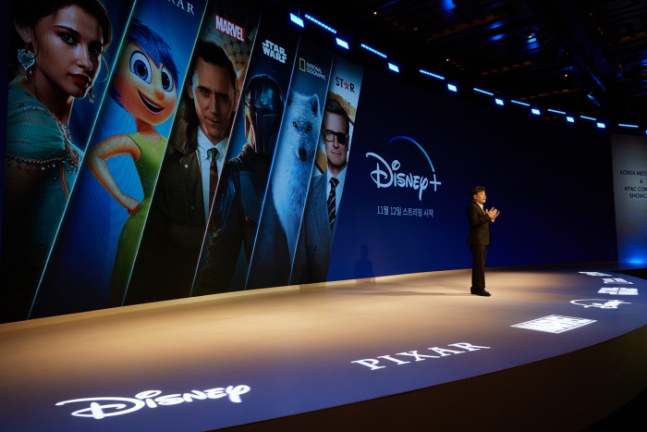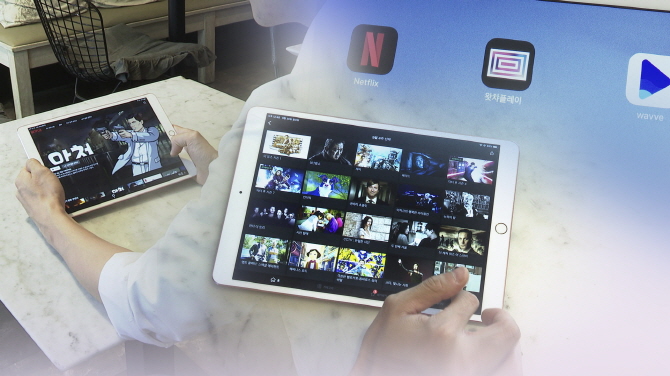SEOUL, Dec. 7 (Korea Bizwire) — Kim Su-yeon, a 39-year old office worker based in Seoul, loves to binge watch Korean TV series on weekends or holidays on the small old TV in her room.
Last week, she finished the latest episodes of romance series like “Melancholia,” “Reflection of You,” “The King’s Affection” and “The Red Sleeve” through her TV equipped with Google Chromecast that enables the device to play internet-streamed video content from Netflix, Disney TV+ and other subscription video-on-demand services.
“I wish I had more time. I often watch TV through the night,” she said. “I subscribe to three services, Netflix, Wavve and Disney TV+, and those three cover nearly all of my favorites.”
She said these online services help her enjoy popular TV programs whenever she wants, without having to download them illegally or buy each episode on video-on-demand sites.
Since Netflix launched its Korean service in 2015, the country’s streaming service market has become one of the fastest-growing and most lucrative industries in the world, with its popular cultural content like K-pop, TV series and films making their presence felt not only in Asia but around the globe.
The market was valued at about 308.9 billion won (US$261.3 million) in 2016, but soared to an estimated 1 trillion won in 2021, according to data by the Korea Communications Commission.
The pandemic-fueled demand for stay-at-home activities has changed the landscape of the local media industry at a faster pace, prompting global and homegrown operators to compete for original slates to entice more subscribers.
Netflix, which has poured a total of $1.2 billion into the market since its launch, has been churning out big-budget Korean-language originals targeting not only Korean viewers but also global audiences every month, including the global sensation “Squid Game” in September, “My Name” in October and “Hellbound” in November.
Its lineup continues with the sci-fi thriller “The Silence” for December.
Homegrown streamers like Wavve and Tving, the No. 2 and No. 3 operators, respectively, are also making efforts to create eye-catching exclusive shows, like “Transit Love,” along with popular series from their mother TV stations, like “The Red Sleeves” and “The King’s Affection.”
Wavve offers programs on the country’s three major terrestrial TV channels KBS, MBC and SBS and Tving on such cable channels as tvN, JTBC, Mnet and OCN.
Global players like Disney+ and Apple TV+ unveiled plans to make Korean-language shows like “Outrun by Running Man,” a spinoff of the popular TV variety show “Running Man,” and “Dr. Brain,” long before launching their service in Korea.
The streamers’ fierce competition to meet the picky demand and tastes of Korean customers has resulted in widening their choice for appetizing shows and films from each platform.
According to a survey by the Korea Consumer Agency in June, nearly 55 percent of 1,800 respondents said they were using at least two online streaming services.
Netflix was chosen by about 58 percent of the multi-service users, followed by Wavve with 23.5 percent and Tving with 22 percent.
At the same time, however, people are voicing complaints that the heated competition and increased amount of content are not always good for them, leading them to narrow their choices.
They said they need to subscribe to all available online video services to enjoy popular original shows provided by each platform.
For example, Koreans have to pay additional 9,900 won to continue their habitual viewing of Marvel series or Pixar animations on Disney+, which were withdrawn from local video-on-demand services and streaming platforms since the beginning of this year as part of preparations for the Disney+ launch in November.
And some early birds or social butterflies have no choice but to subscribe to Netflix to get in on the recent global boom of Korean-language Netflix series led by “Squid Game.”
Subscriptions to five different big-name services of Netflix, Wavve, Tving, Disney+ and Watcha, cost a total of about 43,500 won every month for the cheapest packages.

Walter Disney Company Korea CEO Oh Sang-ho speaks during an Asia-Pacific content showcase of streaming service Disney+ in Seoul on Oct. 14, 2021, in this photo released by the company.
So smart consumers seek ways to share Netflix and other platform’s accounts with others outside their household to lower the monthly bill. Some mobile applications for account sharing are gaining popularity in the country.
Su-yeon, the Korean drama lover, said she is paying some 15,000 won for her three streaming services every month. She shares the subscription to Netflix and Wavve with her brother and Disney+ with her friends.
“Considering my preference and taste for Korean romance series, I think Wavve is enough for me,” she said. “But I can’t stop using Netflix and Disney+ because some of their originals lure me.”
She said Netflix and Disney+ is just for her efforts to keep up with the latest fads, like “Squid Game” and “Hellbound,” which have been the talk of the town for months.
Experts noted increasing dominance of subscription-based online platforms and rising costs may bring about a fresh cultural gap in the country between those who have watched the most-talked-about show and those who haven’t.
They pointed out that people are already paying a monthly 2,500 won for television license fee and some an additional 10,000 won for paid cable channels. And some of them need more to access the up-to-date pop culture streamed only on paid platforms.
“In the past, all people enjoyed the same TV programs on nationwide public TV channels,” said cultural critic Ha Jae-keun.
“But today, the number of subscriptions decides your cultural diversity and breadth. If you don’t have money to use Netflix, you can’t be part of the global sensation ‘Squid Game.’”
(Yonhap)








